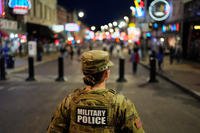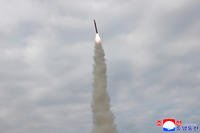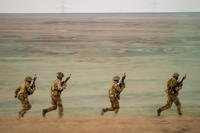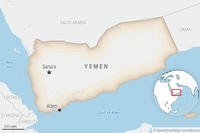The tragic story of an American spy plane with the radio call sign Baron 52 began like so many other midnight missions over Indochina.
Shortly after 11 p.m. on Feb. 4, 1973, the plane left a Thai air force base with a crew of eight whose mission was to eavesdrop on the Ho Chi Minh Trail, North Vietnam’s shadowy, serpentine jungle artery for moving soldiers, tanks, arms and supplies south.
At 1:25 a.m., the flight crew of the EC-47Q radioed Moonbeam, an airborne command and control center, that several artillery rounds were fired at the plane over southern Laos, but it was not hit. Fifteen minutes later, the flight crew reported that the plane was taking on heavy anti-aircraft fire. It was the last time anyone heard from Baron 52 before the converted cargo plane fell out of the sky and landed in the dense Laotian jungle.
But this was no routine shootdown. Only eight days earlier, the United States and its South Vietnamese allies had signed the Paris Peace Accords with North Vietnam and the Viet Cong. A key part of the pact was that the North Vietnamese would return hundreds of U.S. prisoners of war—and the first POWs were set to be released in seven days. The last thing the Americans needed was an international incident to complicate or even nix the deal.
“From the beginning, it was embarrassing to the U.S. because the peace treaty was signed and American prisoners were about to be released—and then all of a sudden there’s a spy mission over the Ho Chi Minh Trail,” recalled former New Hampshire GOP Sen. Bob Smith, who was vice chairman of the Senate Select Committee on POW/MIA Affairs in the early ’90s.
The downing of the reconnaissance plane set off a series of events shrouded in mystery, intrigue, alleged coverups and never-ending questions that remain unanswered today, even as the U.S. gets ready to mark the 50-year anniversary of the ignominious fall of Saigon to Vietnamese communists on April 30, 1975.
To shine a light on the vexing case, The War Horse spent the past two months reviewing hundreds of military and government documents—many of them once top secret and now declassified, or simply gathering dust on archival shelves and never publicized before.
The tale that emerges from the documents, oral histories and video testimonies is one of bureaucratic intransigence and inattention—and one American family’s half-century quest for accountability and truth. The story also drives home the magnitude of the gnawing pain of the families of the nearly 1,600 Americans still listed as “unaccounted for” from the Vietnam War.
CIA’s Secret War
What made the aftermath of Baron 52’s fiery demise even more mysterious was that landlocked Laos during the Vietnam War was the “black hole” of Indochina. The technically neutral country was where the CIA had directed a secret war from the early ’60s to prevent the spread of communism in Southeast Asia by countering the influence of the Pathet Lao, a political and military organization allied with North Vietnam and the Soviet Union.
An aggressive search for Baron 52 involving a flock of U.S. planes was launched 15 minutes after its flight crew didn’t check in with Moonbeam at two a.m. But it took two days to locate the plane in a mountainous region of Laos, about 20 miles from the border of South Vietnam. From the air, search crews reported, it appeared that the plane had fallen to earth, bounced once, landed upside down and burned.
On Feb. 9, a Sikorsky HH- 3E Jolly Green Giant helicopter lowered three Air Force parajumpers and a communications specialist to investigate the crash site after at least one missile was fired at the helicopter. While two of the parajumpers set up a security perimeter, the other two men examined the wreckage. They found the bodies of three members of the flight crew, still strapped into their seats in their fire-resistant Nomex flight suits. And the team found another body partially underneath the fuselage.
But there was no sign of the other four crew members in the main cabin: the navigator and the so-called backenders who operated the sophisticated eavesdropping equipment. The search-and-rescue team determined that all the equipment had been destroyed in the fire. But in part because team members feared booby traps, they didn’t enter the fuselage to sift through the wreckage to look for evidence of the backenders’ demise, such as shredded pieces of Nomex suits. And because one of the mission’s two helicopters was running low on fuel, the search-and-rescue team spent only about 40 minutes on the ground and was able to retrieve the remains of only one of the pilots, 1st Lt. Robert Bernhardt.

Officers at the Front Door
A couple of days later and half a world away on New York’s Long Island, Sgt. Joseph Matejov’s 15-year-old sister, Mary, the sixth of 10 children of Stephen and Mary Matejov, was home sick from school when she peered out the window and spotted two uniformed Air Force officers walk up to the front porch and ring the doorbell.
She had seen similar scenes at the movies and immediately knew something terrible had happened to her fun-loving brother Joe. She told the officers her mother wasn’t home, so they waited in their car for her to return.
“I didn’t even know he was over in Vietnam,” said Mary Matejov Salzinger, a retired nurse who now lives in Portland, Oregon. “I only knew that he was based in Thailand and that I was glad the war had ended without him having to go to Vietnam.”
The news of the fiery crash shattered the Matejov family, but a letter from Col. Francis Humphreys, commander of the 8th Tactical Fighter Wing, based in Ubon, Thailand, offered some hope.
“I feel that there is a possibility that one or more crew members could have parachuted to safety,” Humphreys wrote to Joe’s parents on Feb. 13.
But the Matejovs’ hopes were crushed when they received a letter dated Feb. 24 from Humphreys saying he had reluctantly concluded that all eight men were killed in the crash.
“A careful review of all available facts has been made and there is no reasonable doubt that there were no survivors,” Humphreys wrote. “Due to the severity of the crash, the apparent total destruction of the aircraft, the intense fire and the fact that no contact of any kind was established with any member of the crew, the decision was made to declare your son killed in action.”
‘Conclusive Evidence of Death’
The decision was questioned from the start. Many of the U.S. airmen at the Ubon Royal Thai Air Force Base felt there wasn’t enough evidence to declare the men in the back of the plane dead because Air Force regulations authorize commanders to make a killed-in-action determination only when “conclusive evidence of death” is obtained at any time during the search.
Then, on Feb. 28, the U.S. State Department sent a telegram to its embassy in Vientiane, the Laotian capital, making it clear who should be included on the POW lists being provided to the political wing of the Pathet Lao and the International Committee of the Red Cross. The telegram listed the names of the eight Baron 52 crew members—but it said they “should not be included.”
The Air Force quietly encouraged the Matejovs and the families of the other backenders to hold funerals to help bring about some closure. But the service for Joe, who had turned 21 three days before Baron 52 went down, did little to ease the family’s grief.
The pain felt unbearable when the family watched the joyful, emotional televised scenes on airport tarmacs showing the children, sisters, brothers and wives of returning POWs greeting the men over the next several weeks.
John Matejov, 13 months younger than his brother, felt like he lost part of his soul. Joe and John had been inseparable. The duo had always shared a bedroom and, after they became rambunctious teenagers, would often climb out the bedroom window in the middle of the night to create minor mischief in East Meadow, the sleepy suburban town where they grew up.
After the funeral, the family tried hard to get back to their lives. Some of the Matejov kids went off to college, others to the military.
Steve, Joe’s oldest brother, had joined the Navy, and John the Marines, following in the footsteps of their father, a West Point graduate who earned a Silver Star for valor in the Korean War. After the Baron 52 crash, Theresa went to West Point to begin her Army career.

“We closed our ranks and began a new life as best as we could,” John said.
Then, one summer morning in 1978, investigative journalist Jack Anderson dropped a bombshell.
“Pentagon officials realized this within days of the crash, yet the Air Force never told the families of these men that their loved ones were probably alive,” Anderson reported.
The families of the backenders were shocked. Joe’s mom ripped the “My country right or wrong” bumper sticker off her car. And the Matejovs and other relatives of the backenders began writing members of Congress, questioning the accuracy of military reports and confronting Pentagon officials.
Eventually, the military released the details of the intercept Anderson’s staff had dug up. The documents showed that a U.S. reconnaissance plane flying along the coast of South Vietnam had picked up a communique about six hours after the crash of Baron 52. “Presently Group 210 has four pirates,” a communist soldier reported. “They are going to the control of Mr. Văn. They are going from 44 to 93. They are having difficulties moving along the road.”
In the following months, as all 591 American POWs were gradually released, numerous Air Force officials continued to express serious doubts that the decision to declare the entire crew of Baron 52 dead was the right one.
Even Humphreys seemed to be hedging his bets, conceding in an April 7 letter to Matejov’s family that his decision was partially based on “a certain amount of conjecture in trying to visualize the events as they took place.”
Air Force Col. Lionel Blau had been one of the first to ring the alarm in mid-February 1973. Then a captain who was the operations officer with the 6994th Security Squadron, Blau had the high-level security clearances to examine the intercept and photos of the plane wreckage. He thought Humphreys needed to know exactly what he knew.
“I went in and simply told the colonel, ‘Please do not make that decision yet until we can get straightened out what this [intercept] is about,’” Blau said in a 2023 interview with John Bear, a Colorado researcher and host of the Stories of Sacrifice podcast who volunteers much of his free time to use his forensic genealogy skills to track down the remains of MIAs from past wars through DNA testing.
“I remember very well standing in front of Col. Humphreys and telling him that we had information that indicated that our four guys were still alive, and that I would be glad to show it to him if he would get a top-secret” clearance, Blau told Bear. “And he said, ‘I had one, but I don’t have it now, and I don’t want one.’”
Undeterred, Blau then asked Humphreys to at least let him show him how the plane actually landed in the jungle.
“It did not come in nose first, I told him,” Blau said, contradicting the assessment of the search-and-rescue team that the World War II-vintage EC-47Q plummeted to the ground vertically. “And he said, ‘I’ve flown them, and once they start spinning, nobody’s going to get out. I said, ‘Colonel, that plane was not spinning.’ It came in straight [and horizontally]. The frontenders were still flying that airplane when it came in. And he said, ‘Nope.’ I said, ‘There is no way that they were all KIA at that site.’ He absolutely refused to listen to me.”
A few days later, Humphreys recommended to his higher-ups that all eight Baron 52 crew members be declared killed in action.
The Four-Page Missive
First Lt. Michael Moore might have been killed as well. He was originally on the flight manifest. But at the last minute he took an emergency leave to fly back to Sacramento, California, to be with his wife, Betty, who was having a biopsy for suspected thyroid cancer, according to the Moores’ daughter, Heather Moore Atherton, who lives in nearby Rocklin.
Lt. Bernhardt, the only Baron 52 crew member whose remains were retrieved from the crash site by the search-and-rescue team, took Moore’s place.
After returning from the war, Atherton said, her father struggled for decades with depression, and she always suspected “it was more than just survivor’s guilt.”
Two years after he died in 2017 at age 69 of kidney disease caused by Agent Orange poisoning, Atherton and her mom had a locksmith crack open his safe and discovered the source of his darkness in the safe’s internal chamber.
Moore had left behind a four-page missive about the events surrounding Baron 52 that she found disturbing, said Atherton, who shared her dad’s note with The War Horse, the first time it has ever been made public.
Before her dad flew back to Thailand, he was relieved to find out his wife didn’t have cancer. But the feeling of relief was short-lived. When Moore stopped at a post exchange in the Philippines on the way back to Thailand, he was shocked to pick up a newspaper and learn about the crash.
And when he arrived back at the base, he found the rank and file in open revolt because they thought the Air Force had taken too long to reach the crash site and believed some of the men may have either parachuted out of the plane or survived the crash and walked away from it.
Some members of Sgt. Matejov’s squadron, Moore wrote, were refusing to fly because they believed the Air Force had made the decision to leave men behind out of political expediency.
When Humphreys presented Moore with a report on the crash that concluded all eight were killed, he was asked to sign it. He refused because he considered it “inaccurate and speculation at best,” contrary to intelligence reports and “a serious betrayal of these men and effectively a ‘death warrant’” for them, he wrote in the missive.
But the commander told Moore it was a “direct order,” so he eventually gave in and signed the report.
“I was forced into becoming a part of the conspiracy to cover up the fact that some crew members bailed out,” he wrote.

Missing Cargo Door
Atherton, who believes her father wrote the words in 2008, said finding the note inspired her in 2020 to join the Matejov family’s decades-long fight to have Joe declared MIA rather than KIA. That, the family says, would allow U.S. POW/MIA officials to treat the case more seriously and investigate the many remaining questions.
John Matejov, a Wyoming resident who had taken over the all-consuming family battle after his mother died of a stroke in 2010, had declared himself “done” just months before Atherton introduced herself over the phone a decade later. But her intense interest in the case inspired him to keep going.
In a 1989 Air Force oral history project, Chief Master Sgt. Ronald Schofield, the communications specialist on the search-and-rescue team, said he had changed his mind and no longer believed all of the Baron 52 crew members had perished in the crash. His conversion came when he remembered that the cargo door was missing from the plane when he searched the wreckage.
“These aircraft flew with the doors on. If that aircraft had crashed with the door on, there would have been a little bit of it left at the top,” Schofield said. “There was absolutely nothing. It was gone. It looked like it had been kicked off.”
Roger Shields, the deputy assistant secretary of defense for POW/MIA Affairs at the time, told The War Horse that the shootdown of Baron 52 had jolted U.S. officials involved in POW issues because it indicated the likelihood of U.S. service members being captured after the ceasefire was already in place.
“I had not encountered an intercept from the enemy that so closely described a loss that we knew had occurred,” Shields said from his Florida home. “It was unique.”
He insisted “there was no pressure from the defense secretary or from me—or anybody who had the authority to speak for the department—to declare those men dead,” he said. But he acknowledged that “some individuals in DOD may have tried to apply pressure by speaking for themselves.”
“If anything,” he added, “it could be said that I was the source of pressure in the other direction, with me telling the secretary of the Air Force: ‘I don’t think you’ve made a good decision.’”
But Shields said he was reluctant to get involved because he was outside the chain of command. “It wasn’t my call,” he said.
The POW/MIA issue reached a crescendo in the early ’90s when the Clinton administration moved to end the punishing U.S. trade embargo against Vietnam and establish diplomatic relations with its former enemy. As part of that process, the Senate Select Committee on POW/MIA Affairs held hearings for 14 months beginning in November 1991.
Massachusetts Democratic Sen. John Kerry, a Vietnam vet who had turned against the war, chaired the committee. New Hampshire Sen. Smith, like Kerry, was a Navy vet who served in Vietnam, and was the vice chairman.
Kerry was allied with Arizona GOP Sen. John McCain, who spent more than five years in the Hanoi Hilton as a POW after his Navy plane was shot down in 1967. Both men were determined to forge a new relationship with Vietnam to heal the wounds of the past.
That left Smith as a counterforce. He became a passionate advocate for the families of service members missing in action, calling for full transparency and government accountability.
When Smith asked Robert Destatte, a senior analyst at the U.S. Defense Intelligence Agency, about the “four pirates” intercept, he claimed it had nothing to do with Baron 52. He said as far as the agency could tell, the “pirates” had been captured near Vinh, a city near the coast in North Vietnam that is about 240 miles away from the Baron 52 crash site.
Destatte said the intercept happened at a time when there were at least three South Vietnamese army helicopters down in an area where captured prisoners would have been routed through Vinh.
“And in fact, a personal friend of mine who was a pilot in the [South] Vietnamese Air Force is aware of a friend of his who was the pilot of one of those helicopters. He is aware that the friend, in fact, was captured with his crew and moved to North Vietnam,” Destatte said at the hearing.
It was the only time the Matejovs heard about that theory from anyone in the Defense Intelligence Agency.

Tracking Down Mr. Văn
Bear, the Colorado researcher, believes he might have unraveled the mystery surrounding Mr. Văn with the help of some trusted intelligence sources.
The linguists who translated the radio transmission in February 1973 might have assumed it originated in the Vinh area because the 210th AAA Regiment was historically assigned there, Bear said. Scrolling through a Vietnamese website dedicated to documenting the history of the Ho Chi Minh Trail, Bear discovered that the regiment also fought in the general area of the Baron 52 crash site.
In Vietnam, Văn is an extremely common middle name for males. But it is rarely a given name (which comes last in the Vietnamese order).
The unusual name made it easier for Bear to track down the name of Lương Khánh Văn, who was a political officer of the North Vietnamese army’s 377th Air Division, which oversaw the 210th AAA Regiment, according to CIA records declassified in 2009. Bear found Văn and his division listed on the Ho Chi Minh Trail website.
On Feb. 15, 1973, 10 days after Baron 52 was shot down, the 210th was just south of the crash site near the town of Attapeu in Laos, according to the CIA document.
The reference to “44” in the intercept could have been a reference to Binh Tram 44, which was only about 15 miles from the crash site, Bear said. Binh trams were self-contained military units that oversaw a specific segment of the Ho Chi Minh Trail and were responsible for, among other things, logistical support and air defense.
A Tooth, Four Revolvers
A joint U.S.-Lao group in 1993 conducted an excavation of the Baron 52 crash site around the 20th anniversary of the shootdown. Among other items, the excavators found five lap belt buckles (only three in the locked position), a tooth, three dog tags, and four of the crew’s service revolvers.
The initial report on the excavation said 23 bone fragments were discovered, but that number varied wildly in follow-up reports. Unexplained discrepancies were a continual problem in the Baron 52 documents examined by The War Horse. And the scientists at the U.S. military’s Honolulu laboratory ultimately admitted that they couldn’t say with “100 percent certainty” that the bone fragments were “of human origin,” let alone perform a successful DNA analysis on them.
The diggers also found about two dozen V-rings from at least seven parachutes, but the Matejovs and their lawyers have pointed out that Col. Blau and other members of Joe Matejov’s 6994th Security Squadron have told them they almost always carried extra parachutes.
In a November 1992 survey at the crash site in advance of the excavation, U.S. officials found a dog tag belonging to Matejov on the ground. But crash experts said that meant little because the backenders often chose not to wear their tags, flying “sanitized” in case they were ever captured. Even if Matejov was wearing his dog tag that night, experts said, it could easily have fallen off when the plane turned upside down after impact.
Despite the lack of DNA evidence, the Air Force recommended that the bone fragments be buried in one coffin at Arlington National Cemetery in 1996.
A large tombstone was erected with all eight names on it: Capt. George Spitz, aircraft commander; 1st Lt. Severo Primm III, co-pilot; 1st Robert Bernhardt, co-pilot; Capt. Arthur R. Bollinger, navigator; Sgt. Dale Brandenburg, electronic warfare systems specialist; Staff Sgt. Todd Melton, linguist; Sgt. Peter Cressman and Sgt. Joseph Matejov, airborne Morse systems operators.
As far as the Defense POW/MIA Accounting Agency was concerned, all of the men had now been “accounted for.”
Sen. Smith and some close relatives of the backenders strenuously objected to the collective funeral and burial, arguing that the controversy over Baron 52 was still very much alive.
John Matejov said his mom initially refused to attend the event. But her children convinced her to be there to honor the other families.
No Crater at Crash Site
For years, the Matejovs had begged the Air Force to hold a hearing rather than a funeral. And the family got its wish in 2016 after John Matejov appealed to Defense Secretary Chuck Hagel in a letter during the Obama administration.
Four attorneys working pro bono and Ralph Wetterhahn, a famed plane crash investigator, showed up to present their case for changing Joe’s status from KIA to MIA. The Matejovs were told the two-hour hearing, attended by all of Joe’s siblings, couldn’t be recorded and that Wetterhahn couldn’t show a short video depicting how he believes Baron 52 landed in the jungle because the Pentagon didn’t have the right software to play it.
Wetterhahn had gotten involved in the Baron 52 case when John Matejov hired him about 15 years ago. After investigating the crash through documents and other records, Wetterhahn decided the case was so egregious that he offered to work for free.
A former fighter pilot in Vietnam, Wetterhahn says the Air Force was dead wrong to conclude that the plane had plummeted vertically and hit the ground nose first.
Scrutinizing photos taken from the air during the 1993 excavation, he said, it was obvious the plane came in horizontally on top of the triple-canopy jungle and skipped like a stone on water, flipping over and getting most of its wings sheared off before coming to rest about 400 yards from the point of initial impact.
If the plane had plunged vertically and hit the ground, it would have left a small crater and the plane’s nose would have been crushed. Neither happened, he said.
The cushioned landing would have allowed the backenders to survive the crash and take off on foot, he concluded.
Wetterhahn told The War Horse that declaring all the crew members KIA was a conclusion of convenience to wrap up the case quickly. “They all needed to be dead,” he said.

Captured Alive, Died in Captivity?
Just weeks before the 2016 hearing, attorney Tony Onorato had discovered new evidence through a sweeping document search that he and the Matejovs thought might swing the Air Force their way.
The documents, found at the Sam Johnson Vietnam Archive at Texas Tech University, suggested that the Defense Intelligence Agency still had “as yet unspecified information that some U.S. Air Force personnel lost in February 1973 had been captured alive and had died in captivity.”
The documents were written by Sedgwick Tourison, a former Defense Department intelligence officer who in the ’90s had exposed a headline-grabbing scandal about hundreds of South Vietnamese soldiers who were sent to North Vietnam on spy missions for the U.S. in the early 1960s, only to be abandoned for decades in enemy prison camps.
Tourison discovered that in February 1974 the Defense Intelligence Agency was maintaining a separate MIA accounting system from the Pentagon and had listed the status of the Baron 52 backenders as KK, the code for “died in captivity.” The Pentagon listed Matejov and the other Baron 52 backenders as BB, the code for “killed in action—body not recovered.”
“There is no explanation…that some had been captured alive and then may have been killed, information totally inconsistent with the Air Force’s official version,” wrote Tourison, who did extensive research for the Senate committee.
Shields, the former top POW/MIA official at the Pentagon, told The War Horse he was aware of the separate accounting systems.
In fact, he said he encouraged DIA staffers that he relied on for intelligence relating to prisoners and MIAs “to follow for their own use their perceptions of an individual’s status even if it were contrary to the official, formal status.”
The new evidence, however, made no difference. Eight months after the hearing, John Matejov got a call from a three-star Air Force general saying the secretary of the Air Force had declined the family’s request to change his brother’s status from KIA to MIA.
All the family’s efforts “landed us right back at the starting line,” Matejov said. “It was the same experience for my mom and dad back in the 1970s.”
‘No Man Left Behind’
Many of the key sources who could directly answer the numerous lingering questions surrounding the saga of Baron 52—including Humphreys, Tourison and Schofield—died in the past two decades. The War Horse reached out several times to the Pentagon public affairs office, asking if it could provide a media spokesperson for this story. But we received no response.
One of the major questions is why it took 20 years for the U.S. military to return to the crash site. Initially, the area was deemed too hostile to launch another search operation that would risk more American lives. But even after the Royal Lao government and the Pathet Lao signed a peace treaty and agreed to a ceasefire on Feb. 21, 1973, the U.S. failed to successfully negotiate with the new coalition government to return to the site to meticulously sift through the wreckage of Baron 52 and retrieve more of the crew’s remains.
“To this very day, I am more than ever convinced that the government I had once believed in had literally abandoned Joe in a most egregious manner that totally contradicted the ethos of ‘no man left behind,’ ‘fullest possible accounting,’ and honor,” John Matejov said. “Our family finds itself aligned with so many other families who, I now know, share this very same shameful realization.”
Smith, the former senator, said he sympathized deeply with Matejov because he also felt the same frustrations as vice chairman of the Senate Select Committee—a panel that was created through legislation he wrote.
The Pentagon needs to come clean on the Baron 52 case, Smith said, arguing that it makes little sense to keep so much information classified for so long.
“Unfortunately, there are still dozens of cases like Baron 52,” Smith said.
“Fifty-two years later, we’re still screwing around with these families. Why do they have to pry everything out of the government? Why can’t they just give them all the information all at once? Let them read it, and let them make up their minds.”
This War Horse investigation was reported by Ken McLaughlin, edited by Mike Frankel, and copy-edited by Mitchell Hansen-Dewar. Hrisanthi Pickett wrote the headlines.
Editors Note: This article first appeared on The War Horse, an award-winning nonprofit news organization educating the public on military service. Subscribe to their newsletter.













